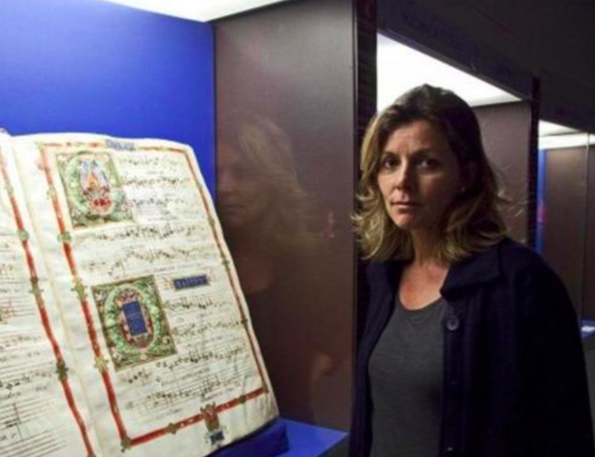


A year after being named the first woman director of the Vatican Museums [2], art historian Barbara Jatta [3] sat down Jan. 29 for a chat with a small group of foreign journalists in Rome. Perhaps inevitably, she was asked if her appointment depended in part upon her being a woman. Her response: "When I began working in the Vatican library over 20 years ago there were just three women. Today half there are women. Times change."
Indeed times do change, as do the ever larger responsibilities her present job entails, from overseeing everything from conservation of some of the world's greatest masterpieces to managing the ever larger crowds entering the Vatican's series of museums and the Sistine Chapel.
A graduate from the La Sapienza University in Rome, this attractive art historian, youthful at 55 years of age, did periods of post-graduate study in the UK, Portugal and the USA. She also taught graphic arts at a university in Naples. Together with the noted art historian Joseph Connors, Jatta co-curated and wrote the catalogue for the exhibition "Vedute romane di Lievin Cruyl: Paesaggio urbano sotto Alessandro VII," published by the American Academy. She was also a co-curator of numerous other exhibitions including on Baroque art.
Then, for over 20 years she worked in the Vatican library, including as curator of its Gabinetto della Stampa, its section dealing with rare prints. From working there, "I learned the ropes -- how the Vatican works," she said with a smile. "Working there gave me strength." After Prof. Antonio Paolucci, museums director for a decade, retired to his native Florence, Pope Francis named Jatta director of the Vatican Museums on Jan. 1, 2017. (For a talk by him in Italian, click here>> [4].)
Jatta and her doctor husband have three children, two boys and a girl. Her work day begins each morning at 6:45. After breakfast she drives her youngest son off to his high school in Rome. By 8 am she is in the office to begin the long, long day of meetings with colleagues and subordinates, of responding to mail and emails from all over the world, and of contacts with curators seeking loans of Vatican works of art for exhibitions outside Italy. One such exhibition is currently underway in Chile while, forthcoming, are major exhibitions of Vatican treasures in Mexico, China and Russia. Yet another is planned for Argentina and, in a more distant future, will take place in the US and involve works by Andy Warhol.
Along with ensuring security, among the toughest problems on Jatta's agenda are the massive crowds flooding into the Vatican Museums. These 6 million annual visitors come no longer on the basis of summer holidays, but year round, with no off-season let-up. Twenty-five thousand daily is the norm, but, "On some days we have as many as 31,000 visitors," said Jatta. To handle the increase, fifteen more custodians were added to the staff of 600, a figure that, when totaled, means that 1,000 employees answer to Jatta. Among them are official guides, who are given courses to keep them up-to-date.
The uniquely popular destination is the Sistine Chapel [5] frescoed by Michelangelo [6]. Today new lighting and careful cleaning have made it more attractive than ever in the past. But given the people pressure, its maintenance requires custodians to use periodically, by night, a machine that can reach 68 feet up to the ceiling to remove the dust and lint left by so many visitors. Asked if limiting their numbers might help resolve the problem, Jatta said firmly, "You simply cannot tell people, who have been dreaming of seeing the Sistine Chapel at least once in a lifetime, that they cannot come."
The Vatican Museums house some 200,000 works, of which 25,000 or so are on view. Besides the better-known museums, like the Etruscan and Ethnographic Museums, the Vatican museums also house seven laboratories for conservation and restoration, staffed by 100 restorers specialized in everything from restoration of paintings and marble sculptures to paper, ceramics, textiles and even straw. One of the earliest and most important of these is the laboratory that restores works sent by missionaries in centuries past -- in some cases those similar in situ are long since lost. And ten restorers are responsible for what Jatta called "preventive restoration" -- checking exhibit items to ensure they do not risk being damaged.
Source URL: http://newsite.iitaly.org/magazine/focus/art-culture/article/meet-barbara-jatta-first-woman-director-vatican-museums
Links
[1] http://newsite.iitaly.org/files/screenshot2018-01-30at41658pmpng
[2] http://www.museivaticani.va/
[3] https://en.wikipedia.org/wiki/Barbara_Jatta
[4] https://www.youtube.com/watch?v=cn15_dJgdGo
[5] http://www.museivaticani.va/content/museivaticani/en/collezioni/musei/cappella-sistina.html
[6] https://www.biography.com/people/michelangelo-9407628